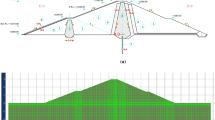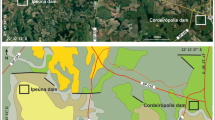Abstract
Internal erosion is the most common reason which induces failure of embankment dams besides overtopping. Relatively large leakage is frequently concentrated at defects of impervious element, and this will lead to eventual failure. The amount of leakage depends not only on integrity of impervious element, but also on dam height, shape of valley, shape of impervious element and water level in reservoir. The integrity of impervious element, which represents the relative level of seepage safety, is not easy to be determined quantitatively. A simple method for generalization of steady seepage state of embankment dams with thin impervious element is proposed in this paper. The apparent overall value of permeability coefficient for impervious element can be obtained by this method with reasonable accuracy and efficiency. A defect parameter of impervious element is defined as an index to characterize seepage safety of embankment dams. It equals the ratio of the apparent overall value of permeability coefficient to the measured value in laboratory for intact materials. Subsequently, seepage safety of three dams is evaluated and the evolution of defect level of impervious element of dams is investigated. It is proved that the newly proposed method in this paper is feasible in the evaluation of relative seepage safety level of embankment dams with thin impervious element.











Similar content being viewed by others
References
Antunes SJ, Vieira Xavier L, Custodio AS, Femandes PR (2007) Performance and concrete face repair at campos novos concrete face rockfill dam. In: Proceedings of the 27th National Seminar of Big Dams, Belem, Brasil, pp 1–15 (in Portuguese)
Casinader R, Rome G (1988) Estimation of leakage through upstream concrete facings of rockfill dams. In: Proceedings of the 16th international congress on large dams, ICOLD, San Francisco, USA, pp 283–310
Chen SS (2012) Breaking machanism and failure process simulation for embankment dams. China Water & Power Press, Beijing
Deng G, Wang XG, Wen YF, Yu S, Chen R (2015) Study on conceptualization method of deformation pattern and horizontal breakage of face slab of concrete faced rockfill dam. J Hydraul Eng 46(4):396–404 (in Chinese)
Fell R, Wan CF, Cyganizewicz J, Foster M (2003) Time for development of internal erosion and piping in embankment dams. J Geotech Geoenvir Eng ASCE 129(4):307–314
Foster M, Fell R, Spannagle M (2011) The statistics of embankment dam failures and accidents. Can Geotech J 37(5):1000–1024
Hunter G, Fell R (2003) The deformation behaviour of embankment dams. University Report No. R-416. The University of New South Wales. Sydney
International Commission on Large Dams (ICOLD) (2017) World Register of Dams. http://www.icold-cigb.org/GB/world_register/general_synthesis.asp
Kunming Engineering Corporation Limited (2006) Bidding and design report on the construction of the dam and cofferdam of Nuozhadu hydroelectirc station on the Lancang River in Yunnan Province (NZD/C3), pp 224–279
National Development and Reform Commission of the Government of the People’s Republic of China (China NDRC) (2007) Design specification for rolled earth-rock fill dams. DL/T 5395-2007, Beijing, China
National Energy Administration of the Government of the People’s Republic of China (NEA of China) (2009) Design specification for hydraulic concrete structures. DL/T 5057-2009, Beijing, China
Novak P, Moffat AIB, Naluri C, Narayanan R (2007) Hydraulic structures. Taylor and Francis, New York
Penman ADM (1986) On the embankment dam. Geotechnique 36:215–262
Sherad JL (1973) Embankment dam cracking. In: Hirschfeld RC, Poulos SJ (eds) Embankment dam engineering (casagrande volume). Wiley, New York, pp 271–353
United States Army Corps of Engineers (USACE) (1993) Engineering and design: seepage analysis and control for dams. EM 1110-2-1901, Washington, DC, USA
Yao NL (2011) Seepage prevention stuctures for a water conservancy project. China New Technol Prod 12:67 (in Chinese)
Zhu JJ, Li T, Du XJ (2009) Analysis on stress and strain before and after the face-slab damage of Sanbanxi dam. Dam Saf 6:46–48 (in Chinese)
Acknowledgements
The authors acknowledge the support of the National Key Research and Development Program of China (No. 2017YFC0404803), the National Nature Science Foundation of China (No. 51578196) and IWHR Research and Development Support Program (GE0145B562017).
Author information
Authors and Affiliations
Corresponding author
Rights and permissions
About this article
Cite this article
Deng, G., Cao, K., Chen, R. et al. A simple approach to evaluating leakage through thin impervious element of high embankment dams. Environ Earth Sci 77, 25 (2018). https://doi.org/10.1007/s12665-017-7195-3
Received:
Accepted:
Published:
DOI: https://doi.org/10.1007/s12665-017-7195-3




